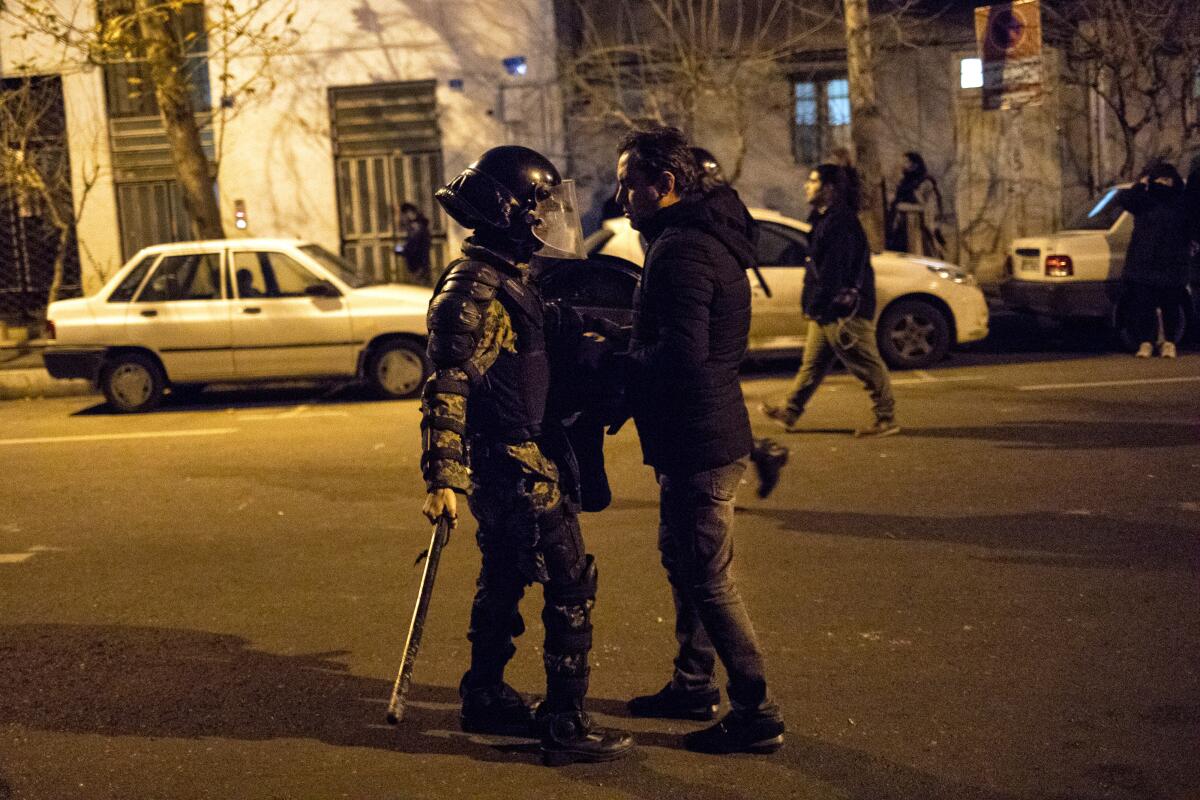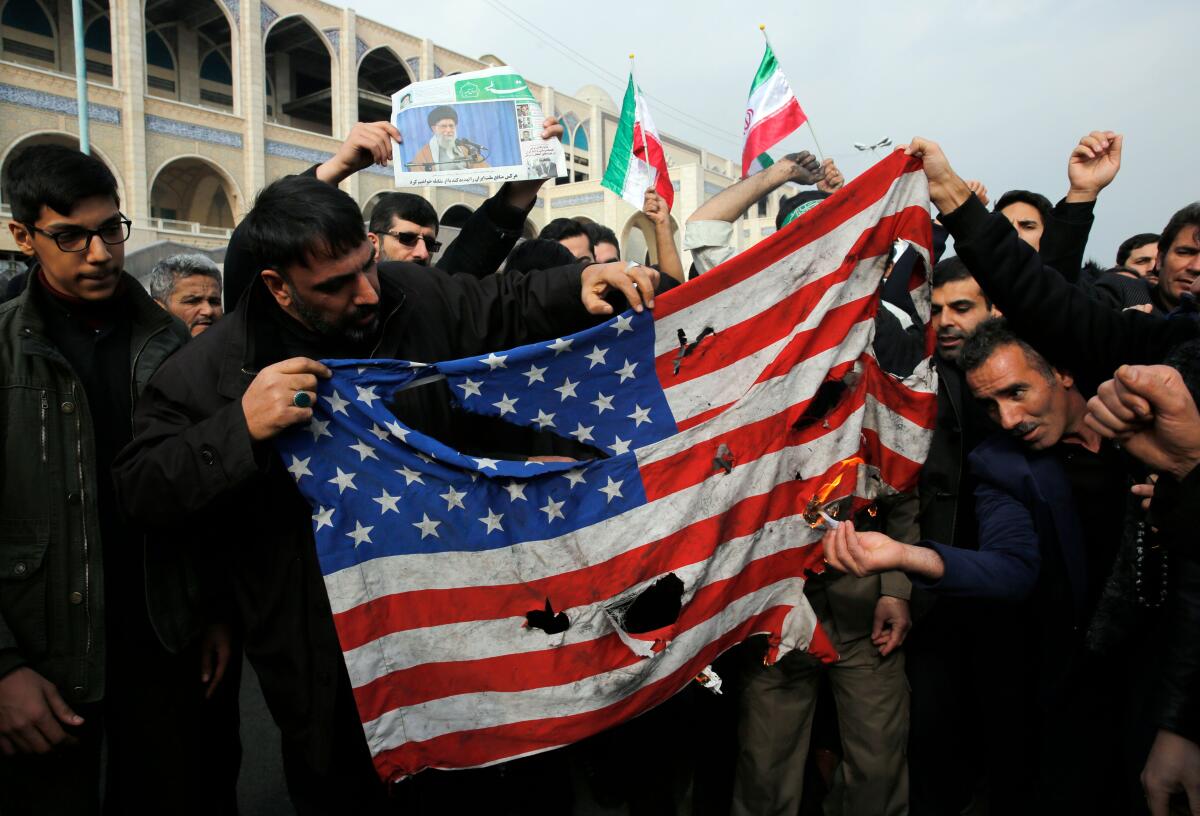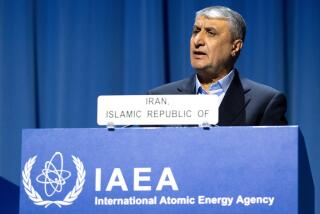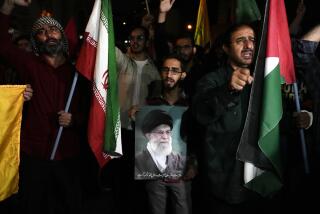Iran’s leader talks tough, but the knives are out for him
- Share via
Despite defiance and fiery rhetoric during a rare Friday sermon, Iran’s supreme leader is facing multiplying dangers: Protesters again in the streets, Europe’s threat of new economic sanctions and President Trump’s drone strike on a top general have shaken a regime that for decades has stayed in power by repressing its people and sowing intrigue across the Middle East.
The sermon was carefully choreographed — worshipers burned and stomped on American flags — as Ayatollah Ali Khamenei said Iran’s ballistic missile barrage last week on a U.S. base in Iraq let his government “slap the face” of Washington. He railed against protesters as betrayers and “stooges of the United States.” He sought to inspire his supporters with images and hyperbole that have been echoing through this theocracy since the 1979 Islamic Revolution.
But his attempts to unify the country appeared to be further undercut by barely a mention of Iran’s accidental shooting down of a Ukrainian airliner last week that killed 176 people. The incident, which Iran denied it had a hand in for days, triggered the latest wave of protests and suggested the regime had misread a population that demanded a transparent accounting of what happened and a swift apology to victims’ families.
The first sermon in eight years by the 80-year-old cleric was much anticipated following the U.S attack in Baghdad that killed Iranian commander Gen. Qassem Suleimani. The latest flare-up between Tehran and Washington turned more fraught after at least 50 people were killed during a stampede along Suleimani’s funeral procession. That was followed by growing furor over the Jan. 8 downing of the Ukrainian civilian plane.
The political and generational fault lines in the country were quickly widening as Revolutionary Guard members fired tear gas and bullets at university protests.

Ali Ghanavati, a Tehran-based journalist, said Khamenei’s sermon disappointed on every political front: “The opposition was waiting to hear radical slogans that would attack them,” he said. “The conservatives were expecting slogans to feed on their usual [divisiveness]. The moderates had hoped for a breakthrough. But ultimately, the Iranian leader did not meet anyone’s expectations.”
Ghanavati said Khamenei’s comments at Tehran’s Grand Mosalla complex were further calibrated not to antagonize Trump in hopes he will be defeated in this year’s election. But that strategy is putting Khamenei, who has ruled Iran since 1989, under tremendous pressure even as he said Iran’s missiles were a “blow to America’s image” and called for U.S. forces to be pushed out of the Middle East.
“Trump killed the Iranian commander to demonstrate that he has no limits,” said Ghanavati. “It remains to be seen which side will win in this political chess game.”
The speech also underlined the isolation and many other troubles the government is navigating.
“One has to read the speech as a failure of the regime to handle its own challenges and the condition its economy is in,” said Ali Akbar Mahdi, a sociology professor at Cal State Northridge. “Corruption is very high and the government is not able to meet the basic needs of its people. The division between nation and government is increasing very fast. It has turned away people from the government. That lack of public trust is the most important thing.”

The Iranian government has been weathering turmoil for months. Unrest broke out in November, when President Hassan Rouhani announced a price hike in gasoline by as much as 50%. Already financially squeezed by Trump’s reimposition of economic sanctions in May 2018 — after he withdrew the U.S. from the landmark nuclear agreement — working-class and lower-income Iranians took to the streets in several cities.
The protests soon morphed into calls for the resignation of some of the Islamic Republic’s top leaders. The demonstrations turned violent when Iran’s security forces clamped down and began shooting. International human rights groups said hundreds of Iranians were killed and thousands detained.
The second spasm of revolt followed the downing of the Ukrainian jet, which came the same night Iran was firing 15 missiles at U.S. bases in Iraq. No American soldiers were killed, but more than 10 were hurt. It took several days before Iranian officials admitted that the plane tragedy was an accident. By then, protests had erupted at universities as students chanted, “Death to the dictator,” and called for Khamenei to step aside.
With victims’ families speaking up, an economy crumbling and protests taking hold, the timing of the supreme leader’s sermon was viewed as a critical opportunity for Khamenei to calm the nation. Rouhani and clerics attended. Supporters chanting, “God is greatest” and “Death to America,” were bused in from provinces as Khamenei evoked outside dangers in an attempt at national unity.
“As much as we were sad about the crash, our enemy was happy about it,” Khamenei said Friday. “They thought they found an excuse to undermine the Islamic Revolutionary Guard Corps and our armed forces and question the Islamic Republic.”
Khamenei last led a Friday sermon eight years ago. During that speech, he criticized U.S. sanctions and called Israel a “cancerous tumor” in the Middle East. Today, some Israeli commentators believe Tehran is too preoccupied with Washington to be an imminent threat.
“The Iranians don’t want two fronts at once,” said Raz Zimmt, a research fellow specializing in Iran at Tel Aviv’s Institute for National Security Studies. “They have a front with the United States and see no reason, for now, to drag Israel into it. I’d be very surprised if they do anything. They have bigger problems right now.”
One of the pillars that has kept the Islamic Republic in control over four decades has been its grip on the military. Hard-liners are also expected to win big in February’s parliamentary elections. Khamenei emphasized the conservative political edge and military connection when he characterized the Quds Force as “combatants without borders.” This was meant as a warning to outside forces and demonstrators, or as he called them, “clowns.” Following a Khamenei sermon in 2009, police and military forces cracked down on the Green Movement protests.
On Friday, Khamenei also addressed European nations in light of news this week that Iran might face a new round of United Nations sanctions over the unraveling of the 2015 nuclear deal and Iran’s move to increase uranium enrichment beyond the accord’s limits.
“The threat of the French and German governments and the vicious British government to send Iran’s case to the Security Council proved once again that they are the footmen of the U.S.,” Khamenei said.
Arman Amiri, a 35-year-old Tehran-based blogger, said many observers this week were expecting Khamenei to deliver a clear path forward, especially given that it had been so long since his last sermon.
“The establishment is desperate to find a way out of the crisis due to wide crackdown on opponents, leaving no option open for negotiation,” Amiri said. He added that although Khamenei’s comments were seen by many as disappointing, there is increasing uncertainty over what will happen next in a country that has long endured national and international hardships.
“In the case of domestic affairs,” said Amiri, “we are missing two important factors: lack of any major political current inside the country to lead opponents and a lack of any well-articulated, clear-cut initiative for the establishment to consider.”
Special correspondent Noga Tarnopolsky in Jerusalem contributed to this report.
More to Read
Sign up for Essential California
The most important California stories and recommendations in your inbox every morning.
You may occasionally receive promotional content from the Los Angeles Times.











